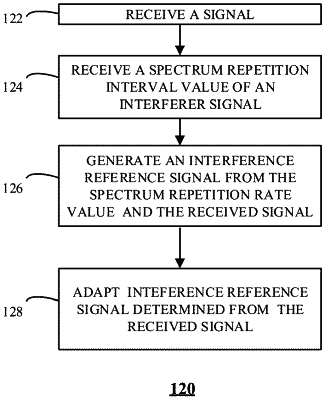| CPC H04B 1/12 (2013.01) | 17 Claims |

|
1. A method of signal processing for a radio receiver, the method comprising:
receiving a signal;
receiving a spectral repetition interval value of an interferer signal, the spectral repetition interval value based on a frequency domain period of repeating interference patterns;
generating an interference reference signal from the received spectral repetition interval value and the received signal, wherein generating the interference reference signal comprises:
applying a time-to-frequency transform to generate a frequency magnitude spectrum of the received signal;
splitting the received signal frequency magnitude spectrum into a plurality of frames, each frame having a number of frequency bins having a magnitude value determined from the spectral repetition interval of the interferer signal;
normalizing a magnitude value of each frequency bin in each frame of the plurality of frames;
determining an interference model frame from the plurality of frames;
generating an extended interference reference model by replicating the interference model frame and de-normalizing each replicated interference model frame;
comparing the frequency bins of the extended interference reference model and the frequency bins of the received signal frequency magnitude spectrum to determine which frequency bins include interference;
modifying the extended interference reference model dependent on the comparison; and
generating the interference reference signal from the modified extended interference reference model; and
adapting the received signal dependent on the interference reference signal.
|